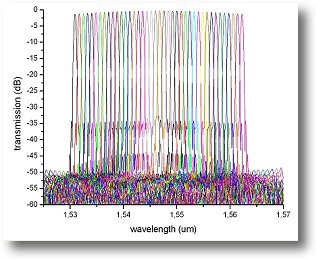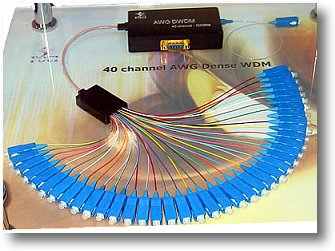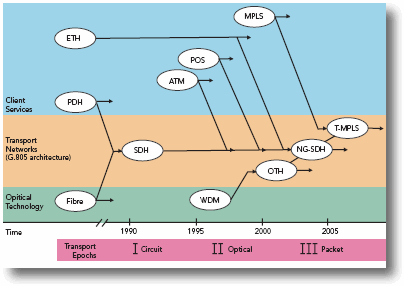Making SDH, DWDM packet friendly
March 2007
Back in 1993, I wrote about the advances taking pace in fiber optic technologies and optical amplifiers. At that time, technology development was principally concerned with improving transmission distances using optical amplifier technology and increasing data rates. These optical cables a single wavelength and hence provided provided a single data channel.
Wide area traffic in the early 1990s was principally dominated by Public Switched Telephone Network (PSTN) telephony traffic as this was well before the explosion in data traffic caused by the Internet. When additional throughput was required, it was relatively simple to lay down additional fibres in a terrestrial environment. Indeed, this became standard procedure to the extent that many fibres were laid in a single pipe with only a few being used or lit as it was known. Unlit fibre strands were called dark fibre. For terrestrial networks when increasing traffic demanded additional bandwidth on a link, it was simple job to simply add additional ports the appropriate SDH equipment and light up an additional dark fibre.
 Wave Division Multiplexing (Picture
credit: photeon)
Wave Division Multiplexing (Picture
credit: photeon)
In undersea cables adding additional fibres to support traffic growth was not so easy so the concept of Wave Division Multiplexing (WDM) came into common usage for point to point links (the laboratory development of WDM actually went back to the 1970s). The use of WDM enabled transoceanic carriers to upgrade the bandwidths of their undersea cables without the need to lay additional cables which would cost multiple billions of Dollars.
As shown in the picture, a WDM based system uses multiple wavelengths thus multiplying the available bandwidth by the number wavelengths that could be supported. The number of wavelengths that could be used and the data rate on each wavelength were limited by the quality of the optical fibre that was being upgraded and the current state-of-the-art of the optical termination electronics. Multiplexers and de-multiplexers at either end of the cable aggregated and split the combined data into separate channels by converted to and from electrical signals.
A number of WDM technologies or architectures were standardised over time. In the early days, Course Wavelength Division Multiplexing (CWDM) was relatively proprietary in nature and meant different things to different companies. CWDM combines up to 16 wavelengths onto a single fibre and uses an ITU standard 20nm spacing between the wavelengths of 1310nm to 1610nm. With CWDM technology, since the wavelengths are relatively far apart compared to DWDM, the are generally relatively cheap.
One of the major issues at the time was that Erbium Doped Fibre Amplifiers (EDFAs) as described in optical amplifiers could not be utilised due to the wavelengths selected or the frequency stability required to be able de-multiplex the multiplexed signals
 In the late 1990s there was an explosion of
development activity aimed at deriving benefit of the concept of Dense Wavelength Division Multiplexing (DWDM) to be able to utilise EDFA amplifiers that operated in 1550nm window.
EDFAs will amplify any number of wavelengths modulated at any data rate as long as they are within its amplification bandwidth.
In the late 1990s there was an explosion of
development activity aimed at deriving benefit of the concept of Dense Wavelength Division Multiplexing (DWDM) to be able to utilise EDFA amplifiers that operated in 1550nm window.
EDFAs will amplify any number of wavelengths modulated at any data rate as long as they are within its amplification bandwidth.
DWDM combines up to 64 wavelengths onto a single fibre and uses an ITU standard that specifies 100GHz or 200GHz spacing between the wavelengths, arranged in several bands around 1500-1600nm. With DWDM technology, the wavelengths are close together than used in CWDM, resulting in the multiplexing equipment being more complex and expensive than CWDM. However, DWDM allowed a much higher density of wavelengths and enabled longer distances to be covered through the use of EDFAs. DWDM systems were developed that could deliver tens of Terabits of data over a single fibre using up to 40 or 80 simultaneous wavelengths e.g. Lucent 1998.
I wouldn't claim to be an expert in the subject, but I would expect that in dense urban environments or over longer runs where access is available to the fibre runs, it is considerably cheaper to install additional runs of fibre than to install expensive DWDM systems. An exception to this would be a carrier installing cables across a continent. If dark fibre is available then it's an even simpler decision.
Although considerable advances were taking place at optical transport with the advent of DWDM systems, existing SONET and SDH standards of the time were limited to working with a single wavelength per fibre and were also limited to working with single optical links in the physical layer. SDH could cope with astounding data rates on a single wavelengths, but could not be used with emerging DWDM optical equipment.
Optical Transport Hierarchy
This major deficiency in SDH / SONET led to further standards development initiatives to bring it "up to date". These are known as the Optical Transport Network (OTN) working in an Optical Transport Hierarchy (OTH) world. OTH is the same nomenclature as used for PDH and SDH networks.
The ITU-T G.709 (released between 1999 - 2003) standard Interfaces for the OTN is a standardised set of methods for transporting wavelengths in a DWDM optical network that allows the use of completely optical switches known as Optical Cross Connects that does not require expensive optical-electrical-optical conversions. In effect G.709 provides a service abstraction layer between services such as standard SDH, IP, MPLS or Ethernet and the physical DWDM optical transport layer. This capability is also known as OTN/WDH in a similar way that the term IP/MPLS is used. Optical signals with bit rates of 2.5, 10, and 40 Gbits/s were standardised in G.709 (G.709 overview presentation) (G.709 tutorial).
The functionality added to SDH in G.709 is:
-
Management of optical channels in the optical domain
-
Forward error correction (FEC) to improve error performance and enable longer optical spans
-
Provides standard methods for managing end to end optical wavelengths
Other SDH extensions to bring SDH up to date and make it 'packet friendly'
Almost in parallel with the development of G.709 standards a number of other extensions were made to SDH to make it more packet friendly.
Generic Framing Procedure (GFP): The ITU, ANSI, and IETF have specified standards for transporting various services such as IP, ATM and Ethernet over SONET/SDH networks. GFP is a protocol for encapsulating packets over SONET/SDH networks.
Virtual Concatenation (VCAT): Packets in data traffic such as Packet over SONET (POS) are concatenated into larger SONET / SDH payloads to transport them more efficiently.
Link Capacity Adjustment Scheme (LCAS): When customers' needs for capacity change, they want the change to occur without any disruption in the service. LCAS a VCAT control mechanism, provides this capability.
These standards have helped SDH / SONET to adapt to an IP or Ethernet packet based world which was missing in the original protocol standards of the early 1990s.
Next Generation SDH (NG-SDH)
If a SONET or SDH network is deployed with all the extensions that make it packet friendly is deployed it is commonly called a Next Generation SDH (NG-SDH). The diagram below, shows the different ages of SDH concluding in the latest ITU standards work called T-MPLS ( I cover T-MPLS in: PBT - PBB-TE or will it be T-MPLS?

Transport Ages (Picture credit: TPACK)
Multiservice provisioning platform (MSPP)
Another term in widespread use with advanced optical networks is MSPP.
SONET / SDH equipment use what are known as add / drop multiplexers (ADMs) to insert or extract data from an optical link. Technology improvements enabled ADMs to include cross-connect functionality to manage multiple fibre rings and DWDM in a single chassis. These new devices replaced multiple legacy ADMs and also allow connections directly from Ethernet LANs to a service provider's optical backbone. This capability was a real benefit to Metro networks sitting between enterprise LANs and long distance carriers.
There are many variant acronyms in use as there are equipment vendors:
-
Multiservice provisioning platform (MSPP): includes SDH multiplexing, sometimes with add-drop, plus Ethernet ports, sometimes packet multiplexing and switching, sometimes WDM.
-
Multiservice switching platform (MSSP): an MSPP with a large capacity for TDM switching.
-
Multiservice transport node (MSTN): an MSPP with feature-rich packet switching.
-
Multiservice access node (MSAN): an MSPP designed for customer access, largely via copper pairs carrying Digital-Subscriber Line (DSL) services.
-
Optical edge device (OED): an MSSP with no WDM functions.
This has been an interesting post in that it has brought together many of the technologies and protocols discussed in the previous posts, in particular SDH, Ethernet and MPLS and joined them to optical networks. It seem strange to say on one hand that the main justification of deploying converged Next Generation Networks (NGNs) based on IP is to simplify existing networks and hence reduce costs, but then consider the complexity and plethora of acronyms and standards associated with that!
I think there is only one area that I have not touched upon and that is the IETF's initiative - Generalised MPLS (GMPLS) or ASON / ASTN, but that is for another day!
